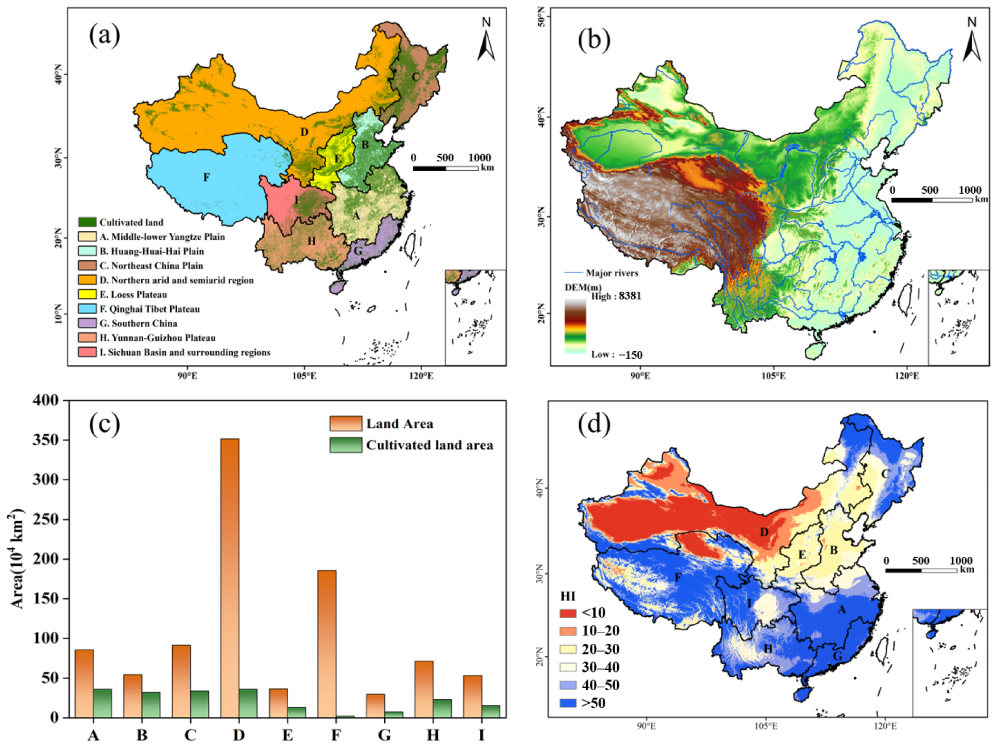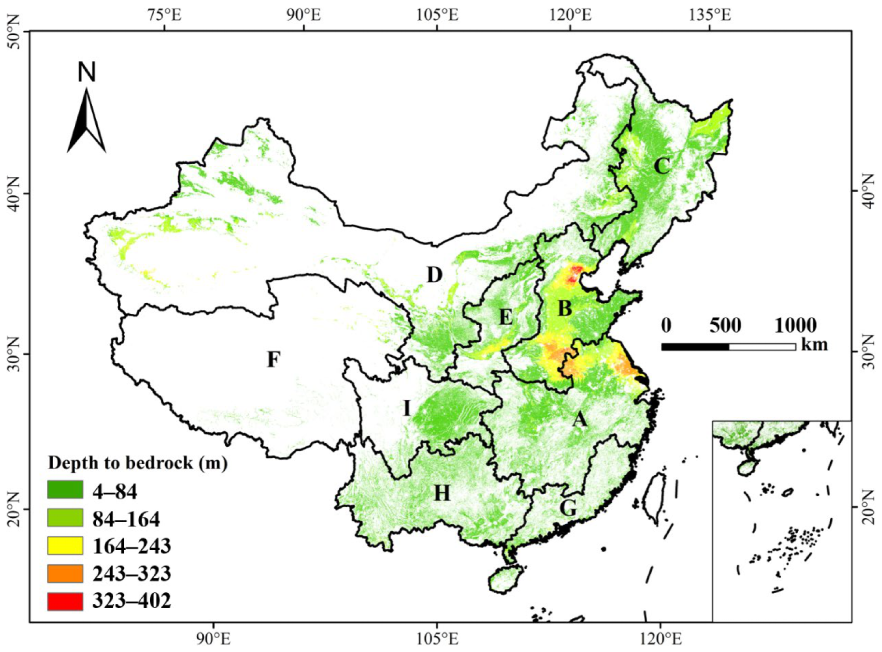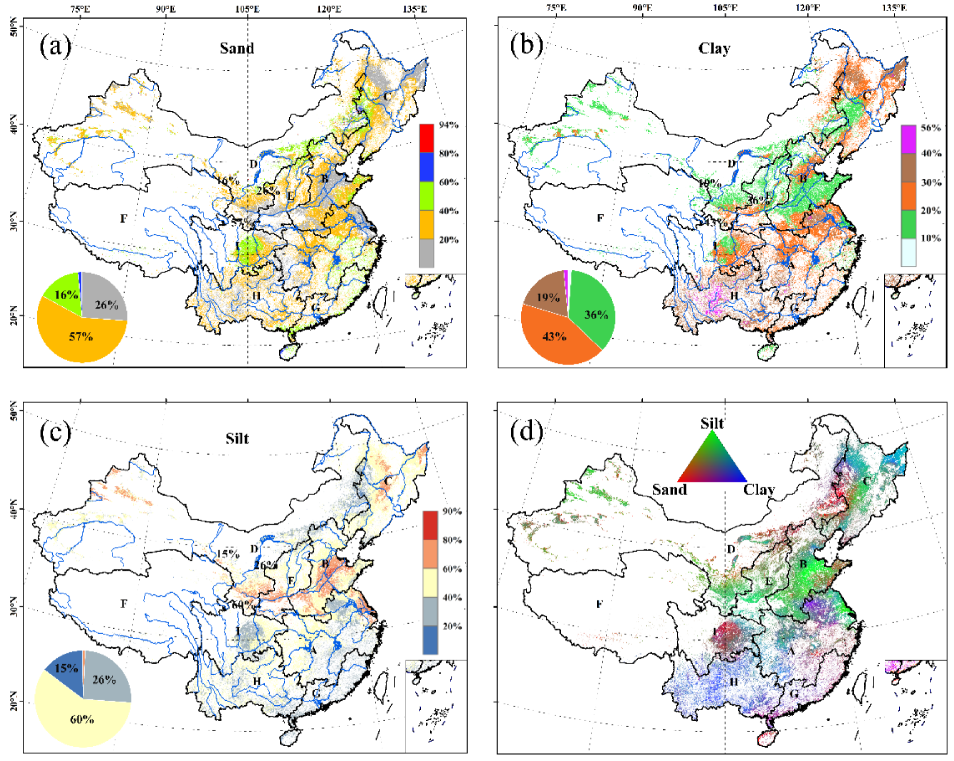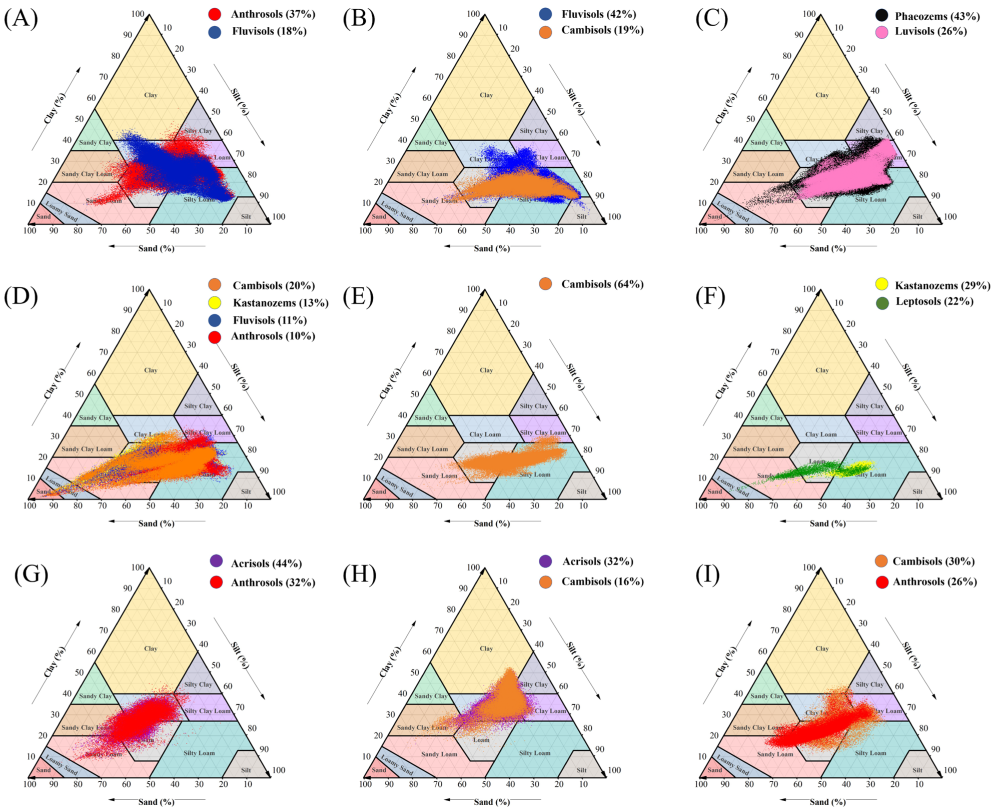Particle Size Distribution and Depth to Bedrock of Chinese Cultivated Soils: Implications for Soil Classification and Management
Abstract
1. Introduction
2. Materials and Methods
2.1. Study Site
2.2. Data
2.3. Data Analysis
3. Results
3.1. Distribution of Cultivated Land in Agricultural Zones
3.2. Depth Distribution of Cultivated Soils in Relation to Soil Types
3.3. Particle Size Distribution of Cultivated Soils in Agricultural Zones
4. Discussion
4.1. Factor Effects on Cultivated Soil Development
4.2. Soil Classification Development for Cultivated Land Use
5. Conclusions
Author Contributions
Funding
Conflicts of Interest
References
- Jenny, H. Factors of Soil Formation: A System of Quantitative Pedology; McGraw-Hill Book Company Inc.: New York, NY, USA, 1941. [Google Scholar]
- Roy, W.S. Factors of soil formation. A system of quantitative pedology. Geoderma 1994, 68, 334–335. [Google Scholar]
- Dror, I.; Yaron, B.; Berkowitz, B. The Human Impact on All Soil-Forming Factors during the Anthropocene. ACS Environ. Au 2021, 2, 11–19. [Google Scholar] [CrossRef] [PubMed]
- Kuzyakov, Y.; Zamanian, K. Reviews and syntheses: Agropedogenesis—Humankind as the sixth soil-forming factor and attractors of agricultural soil degradation. Biogeosciences 2019, 16, 4783–4803. [Google Scholar] [CrossRef]
- Pérez, F.L. Biogeomorphic influence of soil depth to bedrock, volcanic ash soils, and surface tephra on silversword distribution, Haleakalā Crater (Maui, Hawai’i). Geomorphology 2015, 243, 75–86. [Google Scholar] [CrossRef]
- Bresler, E.; Dagan, G.; Wagenet, R.J.; Laufer, A. Statistical Analysis of Salinity and Texture Effects on Spatial Variability of Soil Hydraulic Conductivity. Soil Sci. Soc. Am. J. 1984, 48, 16–25. [Google Scholar] [CrossRef]
- Seaton, F.M.; George, P.B.; Lebron, I.; Jones, D.L.; Creer, S.; Robinson, D.A. Soil textural heterogeneity impacts bacterial but not fungal diversity. Soil Biol. Biochem. 2020, 144, 107766. [Google Scholar] [CrossRef]
- Liu, F.; Zhang, G.-L.; Song, X.; Li, D.; Zhao, Y.; Yang, J.; Wu, H.; Yang, F. High-resolution and three-dimensional mapping of soil texture of China. Geoderma 2020, 361, 114061. [Google Scholar] [CrossRef]
- Montanarella, L.; Vargas, R. Global governance of soil resources as a necessary condition for sustainable development. Curr. Opin. Environ. Sustain. 2012, 4, 559–564. [Google Scholar] [CrossRef]
- Padarian, J.; Minasny, B.; McBratney, A.B. Chile and the Chilean soil grid: A contribution to GlobalSoilMap. Geoderma Reg. 2017, 9, 17–28. [Google Scholar] [CrossRef]
- Rossel, R.A.V.; Chen, C.; Grundy, M.; Searle, R.; Clifford, D.; Campbell, P.H. The Australian three-dimensional soil grid: Australia’s contribution to the GlobalSoilMap project. Soil Res. 2015, 53, 845–864. [Google Scholar] [CrossRef]
- Radziuk, H.; Świtoniak, M. The effect of erosional transformation of soil cover on the stability of soil aggregates within Young Hummocky Moraine Landscapes in Northern Poland. Agronomy 2022, 12, 2595. [Google Scholar] [CrossRef]
- Le Bissonnais, Y. Aggregate stability and assessment of soil crustability and erodibility: I. Theory and methodology. Eur. J. Soil Sci. 1996, 47, 425–437. [Google Scholar] [CrossRef]
- Martín, M.Á.; Reyes, M.; Taguas, F.J. Estimating soil bulk density with information metrics of soil texture. Geoderma 2017, 287, 66–70. [Google Scholar] [CrossRef]
- Ruggeri, R.; Tolomio, M.; Muganu, M.; Loreti, P.; Virga, G.; Iacuzzi, N.; Rossini, F. Establishment of a commercial organic hopyard in a Mediterranean environment: Production attributes and their relationship with soil texture. Sci. Hortic. 2023, 310, 111720. [Google Scholar] [CrossRef]
- Li, X.; Feng, Y.J. Carbon Sequestration Potentials in Agricultural Soils; Alberta Research Council Inc.: Edmonton, AB, Canada, 2002. [Google Scholar]
- Sun, W.; Huang, Y.; Zhang, W.; Yu, Y. Carbon sequestration and its potential in agricultural soils of China. Glob. Biogeochem. Cycles 2010, 24, 1–12. [Google Scholar] [CrossRef]
- Doran, J.W. Soil health and global sustainability: Translating science into practice. Agric. Ecosyst. Environ. 2002, 88, 119–127. [Google Scholar] [CrossRef]
- Jia, S.; Yuan, D.; Li, W.; He, W.; Raza, S.; Kuzyakov, Y.; Zamanian, K.; Zhao, X. Soil Chemical Properties Depending on Fertilization and Management in China: A Meta-Analysis. Agronomy 2022, 12, 2501. [Google Scholar] [CrossRef]
- Yang, Z.; Hu, Y.; Zhang, S.; Raza, S.; Wei, X.; Zhao, X. The Thresholds and Management of Irrigation and Fertilization Earning Yields and Water Use Efficiency in Maize, Wheat, and Rice in China: A Meta-Analysis (1990–2020). Agronomy 2022, 12, 709. [Google Scholar] [CrossRef]
- Pernes-Debuyser, A.; Tessier, D. Soil physical properties affected by long-term fertilization. Eur. J. Soil Sci. 2004, 55, 505–512. [Google Scholar] [CrossRef]
- Morugán-Coronado, A.; Pérez-Rodríguez, P.; Insolia, E.; Soto-Gómez, D.; Fernández-Calviño, D.; Zornoza, R. The impact of crop diversification, tillage and fertilization type on soil total microbial, fungal and bacterial abundance: A worldwide meta-analysis of agricultural sites. Agric. Ecosyst. Environ. 2022, 329, 107867. [Google Scholar] [CrossRef]
- Zhao, Y.; Wang, M.; Hu, S.; Zhang, X.; Ouyang, Z.; Zhang, G.; Huang, B.; Zhao, S.; Wu, J.; Xie, D.; et al. Economics- and policy-driven organic carbon input enhancement dominates soil organic carbon accumulation in Chinese croplands. Proc. Natl. Acad. Sci. USA 2018, 115, 4045–4050. [Google Scholar] [CrossRef] [PubMed]
- Zhang, H.; Ouyang, Z.; Jiang, P.; Li, M.; Zhao, X. Spatial distribution patterns and influencing factors of soil carbon, phosphorus, and C:P ratio on farmlands in southeastern China. Catena 2022, 216, 106409. [Google Scholar] [CrossRef]
- Li, T.X. Report of China’s National Dialogue on Food Security and Sustainable Development for the United Nations Food Systems Summit (Chapter 6); United Nations: New York, NY, USA, 2021; pp. 327–328. [Google Scholar]
- Liu, F.; Wu, H.; Zhao, Y.; Li, D.; Yang, J.L.; Song, X.; Shi, Z.; Zhu, A.-X.; Zhang, G.L. Mapping high resolution National Soil Information Grids of China. Sci. Bull. 2022, 67, 328–340. [Google Scholar] [CrossRef]
- Zhou, T.; Geng, Y.; Ji, C.; Xu, X.; Wang, H.; Pan, J.; Bumberger, J.; Haase, D.; Lausch, A. Prediction of soil organic carbon and the C: N ratio on a national scale using machine learning and satellite data: A comparison between Sentinel-2, Sentinel-3 and Landsat-8 images. Sci. Total Environ. 2021, 755, 142661. [Google Scholar] [CrossRef]
- Zhou, T.; Geng, Y.; Chen, J.; Pan, J.; Haase, D.; Lausch, A. High-resolution digital mapping of soil organic carbon and soil total nitrogen using DEM derivatives, Sentinel-1 and Sentinel-2 data based on machine learning algorithms. Sci. Total Environ. 2020, 729, 138244. [Google Scholar] [CrossRef]
- Shangguan, W.; Dai, Y.; Liu, B.; Ye, A.; Yuan, H. A soil particle-size distribution dataset for regional land and climate modelling in China. Geoderma 2012, 171–172, 85–91. [Google Scholar] [CrossRef]
- Yan, F.; Shangguan, W.; Zhang, J.; Hu, B. Depth-to-bedrock map of China at a spatial resolution of 100 meters. Sci. Data 2020, 7, 2. [Google Scholar] [CrossRef] [PubMed]
- Zhang, M.K. Soil clayization and argic horizon identification in mountain and hilly areas of southern China. J. Agric. 2021, 11, 53–57, (In Chinese with English abstract). [Google Scholar]
- Xie, H.H.; Wu, Q.G.; Hu, J.Y.; Yu, L.F.; Bie, P.F.; Wang, H.; Deng, D.Z. Changes in soil physical and chemical properties during the process of alpine meadow degradation along the eastern Qinghai-Tibet Plateau. Eurasian Soil Sci. 2018, 51, 1440–1446. [Google Scholar] [CrossRef]
- Halecki, W.; Kruk, E.; Ryczek, M. Loss of topsoil and soil erosion by water in agricultural areas: A multi-criteria approach for various land use scenarios in the Western Carpathians using a SWAT model. Land Use Policy 2018, 73, 363–372. [Google Scholar] [CrossRef]
- FAO; IIASA; ISRIC; ISS-CAS; JRC. Harmonized World Soil Database (Version 1.1); FAO: Rome, Italy; IIASA: Laxenburg, Austria, 2009. [Google Scholar]
- Lan, J. Comparison Characteristics of Weathering Degree, Clay Minerals and Iron Oxides of Carbonate Weathering Crusts at Different Altitude in West Yunnan-Guizhou Plateau; Yunnan Normal University: Kunming, China, 2021; (In Chinese with English abstract). [Google Scholar]
- Cai, Y.F. Enrichment and Distribution of Pedogenic Iron Oxides and Its’ Climatic and Tectonic Significance in Yunnan-Guizhou Plateau; Southwest University: Chongqing, China, 2021; (In Chinese with English abstract). [Google Scholar]
- Guo, S.; Cai, Y.; Ren, J.; Guan, Y.; Xin, D.; Long, X. Formation and migration of magnetic particles associated with iron oxide transformation at a hillslope scale. Catena 2021, 197, 104944. [Google Scholar] [CrossRef]
- Zhang, F.R.; Huang, Q.; Zhang, D. The significance of clayey layer, Its criteria for series classification in the nouth china plain. Chin. J. Soil Sci. 2001, 5, 197–200, (In Chinese with English abstract). [Google Scholar]
- Yi, W.; Wang, S.; Yang, S.; Zhao, H.; Jin, X.; Wang, G. Humus distribution and forms in the sediments from shallow lakes in the middle and lower reaches of the Yangtze River. J. Lake Sci. 2011, 23, 21–28. [Google Scholar]
- Xiang, T.T. Studying on the Process of Erosion-Deposition of Eastern Slope of Great Khingan and Its Indicative Significance; Jilin University: Changchun, China, 2014; (In Chinese with English abstract). [Google Scholar]
- Duan, J.L.; Zhang, G.; Ren, Y.Y.; Zhang, X.L.; Li, W.D. Study on Interactive Relationship between Spatial Distribution Pattern of Soil and Surface Water. Soils 2021, 53, 1072–1080, (In Chinese with English abstract). [Google Scholar]
- Gavinelli, F.; Fusaro, S.; Ivan, D.; Ragusa, S.; Paoletti, M.G. Unpredicted ecological and ecosystem services of biodiversity. Spontaneous vegetation, hedgerows, and maple trees as useful landscape components to increase predatory mite population in agroecosystems. Appl. Soil Ecol. 2020, 154, 103584. [Google Scholar] [CrossRef]
- Dong, Y.; Yang, J.-L.; Zhao, X.-R.; Yang, S.-H.; Mulder, J.; Dörsch, P.; Peng, X.-H.; Zhang, G.-L. Soil acidification and loss of base cations in a subtropical agricultural watershed. Sci. Total Environ. 2022, 827, 154338. [Google Scholar] [CrossRef]
- Ng, E.L.; Lwanga, E.H.; Eldridge, S.M.; Johnston, P.; Hu, H.W.; Geissen, V.; Chen, D. An overview of microplastic and nanoplastic pollution in agroecosystems. Sci. Total Environ. 2018, 627, 1377–1388. [Google Scholar]
- Hughes, P.; McBratney, A.B.; Huang, J.; Minasny, B.; Micheli, E.; Hempel, J. Comparisons between usda soil taxonomy and the australian soil classification system i: Data harmonization, calculation of taxonomic distance and inter-taxa variation. Geoderma 2017, 307, 198–209. [Google Scholar] [CrossRef]
- Esfandiarpour-Borujeni, I.; Mosleh, Z.; Farpoor, M.H. Comparing the ability of soil taxonomy (2014) and wrb (2015) to distinguish lithologic discontinuity and an abrupt textural change in major soils of iran. Catena 2018, 165, 63–71. [Google Scholar] [CrossRef]
- Weng, H.L.; Ci, E.; Lian, M.S.; Chen, L.; Hu, J. The origin of acidic purple soil in chongqing and its significance for soil genetic classification. J. Southwest Univ. 2019, 41, 32–39, (In Chinese with English abstract). [Google Scholar]





Disclaimer/Publisher’s Note: The statements, opinions and data contained in all publications are solely those of the individual author(s) and contributor(s) and not of MDPI and/or the editor(s). MDPI and/or the editor(s) disclaim responsibility for any injury to people or property resulting from any ideas, methods, instructions or products referred to in the content. |
© 2023 by the authors. Licensee MDPI, Basel, Switzerland. This article is an open access article distributed under the terms and conditions of the Creative Commons Attribution (CC BY) license (https://creativecommons.org/licenses/by/4.0/).
Share and Cite
Zhao, X.; He, W.; Xue, L.; Chen, F.; Jia, P.; Hu, Y.; Zamanian, K. Particle Size Distribution and Depth to Bedrock of Chinese Cultivated Soils: Implications for Soil Classification and Management. Agronomy 2023, 13, 1248. https://doi.org/10.3390/agronomy13051248
Zhao X, He W, Xue L, Chen F, Jia P, Hu Y, Zamanian K. Particle Size Distribution and Depth to Bedrock of Chinese Cultivated Soils: Implications for Soil Classification and Management. Agronomy. 2023; 13(5):1248. https://doi.org/10.3390/agronomy13051248
Chicago/Turabian StyleZhao, Xiaoning, Wei He, Lihua Xue, Feng Chen, Pingping Jia, Yi Hu, and Kazem Zamanian. 2023. "Particle Size Distribution and Depth to Bedrock of Chinese Cultivated Soils: Implications for Soil Classification and Management" Agronomy 13, no. 5: 1248. https://doi.org/10.3390/agronomy13051248
APA StyleZhao, X., He, W., Xue, L., Chen, F., Jia, P., Hu, Y., & Zamanian, K. (2023). Particle Size Distribution and Depth to Bedrock of Chinese Cultivated Soils: Implications for Soil Classification and Management. Agronomy, 13(5), 1248. https://doi.org/10.3390/agronomy13051248




